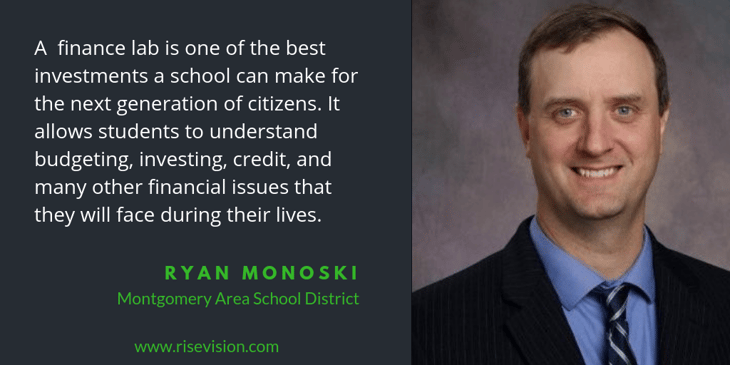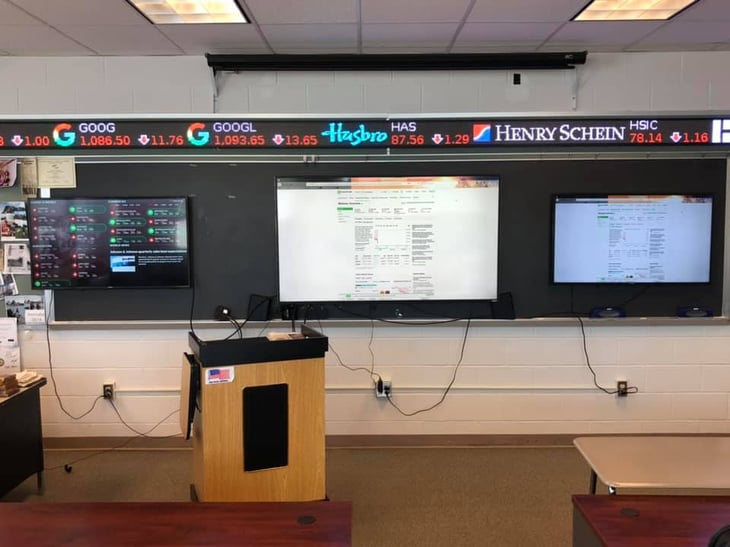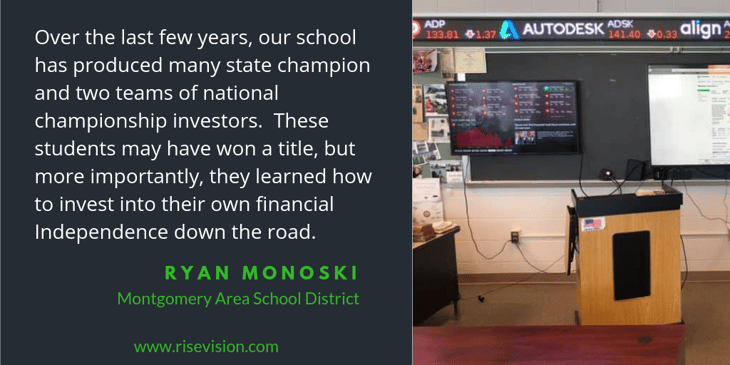
Ryan Monoski visited Penn State’s financial literacy lab and had one thought: why can’t his high school kids have something that cool and educational too? Most people would say it’s because Penn State is a college and has lots of money; Monoski, a former stockbroker turned high school finance teacher for the Montgomery Area School District, decided not to let money stop him from getting his students the finance lab they deserved.
Monoski has since created one of the best high school finance labs in the country. His students have won multiple state and national finance competitions. This post will show you how your school can follow his model.
If you are interested in seeing Monoski in action, check out this video, which was produced by Charles Schwab:
Why Do Schools Need Finance Labs?
Money is tight for every public school. In a dream world, your school should have everything; unfortunately, it’s not a dream world, and the question must be asked: why do schools even need finance labs?
Monoski has spent 15 years teaching and knows exactly why: students aren’t prepared with financial knowledge when they leave school. When they enter college they’re already a step behind all the students who had financial training in high school, and it gets worse with all the loan and credit offers they are bombarded with.
To an 18-year-old, the offers seem too good to be true...and for good reason: they are too good to be true. Suddenly, they can have expensive phones, computers, and more, and they have zero knowledge about debt and risks entailed by accepting the offers. Further, for some students, school might be the only chance they have to learn about retirement and savings before they enter the workforce.
For schools, Monoski believes a finance lab is “one of the best investments a school can make for the next generation of citizens. It allows students to understand budgeting, investing, credit, and many other financial issues that they will face during their lives.”

How to Get Started
If you are looking to create a finance lab at your high school or college, you can start by reading this post.
Monoski didn’t start big. He knew it was unrealistic to get everything he wanted at once. Instead, he took a bootstrap approach where he’d show how one resource is applied in the classroom and used it to build interest and help fund other resources.
His first step was to speak to his superintendent. He told her about his vision and why it was needed. Once she was on board, his next step was reaching out to the school foundation and local businesses to ask for contributions.
Monoski’s advice was to pitch the vision to the students first; if he couldn’t get students excited about it, then he knew he wouldn’t be able to sell it to parents. When students understood what he wanted to do, they would go home and excitedly tell their parents, many of whom were part of the school foundation, all about it.
What’s most impressive about Montgomery’s lab is that it’s entirely funded by grants and donations. It’s a great example of how a little motivation can create a program that is life changing for students.
The biggest hurdle for Monoski was fundraising. He persistently knocked on doors for months to get seed money for the first steps. Many people loved the idea of the program but wanted to see something before making the initial investment. Our website has some great pictures of how others have set up their labs and the financial content we offer to help them look great.
Schools in need of money for their lab can check out this post on tech grants for schools. This post gives you some tips for applying to grants, and this post has some creative ways you can fundraise for your digital signage equipment.
What Activities Are There for Finance Labs?
Monoski says one of the best things about having a finance lab is the teaching is no longer just out of the book. Before the lab, he felt like it was him standing in front of students reading something. Now students are creating college-level presentations on subjects not expected in a high school setting.
Students learn better when it’s a more hands-on environment, where the education is more visual. That’s what his lab does. His student's trade virtual money in a stock game and the learning feels more like a game than education. About 20 to 24 students take each of his classes.

A Finance Lab is Never Complete
Monoski’s journey to create a finance lab started about three years ago. His room now has a stock ticker and three displays for teaching and showing financial data. But his journey doesn’t stop there. He is continuing to raise money for more hardware (such as new computers for his students). The finance industry is always evolving, and he is always looking for more ways to incorporate technology in the classroom.
You can see what Monoski’s classroom looks like below.

Students who have taken his classes have gone on to major in business at colleges around the country, and are more prepared than other students. Monoski’s students have won many state and national investment championships, but more importantly for Monoski, “ they learned how to invest into their own financial Independence down the road.”

Next Steps
Interested in creating a finance lab at your school? Contact us and we'll guide you through the process.





